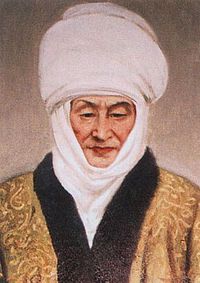Yellow Robe Society
The Yellow Robe Society, or ස්හර් නෝඕම්රෝඕග් (shar noomroog), was a political and economic system that persisted independently from the end of the Sarmin Khanate until the rise of the Khyalbar Khanate. The Yellow Robes were the leaders of towns and sometimes members of nomad tribes who helped organize the distribution of land in their vicinity, cared for the sick, and recorded agreements. In Euclean territories during the colonial period, they were characterized as lawyer-mayors who occasionally practiced folk medicine. They were the only non-tribal government in the southern Mirghazab towns and competed with the Sorsanid Empire for influence. They worked on the basis of mutual recognition which was made possible by the use of apprentices who would ride the hundreds of miles between towns to relay information.
They wore yellow silk provided by the tribal leaders to help make them easily distinguishable from fraudsters. Over time, these uniforms became more elaborate as officials embroidered them with plant patterns (animals were often symbols of individual tribes and therefore were never used) or attached ivory beads to them. The robes were passed down until they were no longer wearable at which point they were torn into strips and used as decorations for the apprentices. Since sink was difficult to acquire and maintain, sometimes officials were forced to wear only a sash of yellow silk and even yellow dyed wool.
While they were not originally physicians, they were well-situated to host the temporarily ill for a season while their tribes continued up into the hills for summer. They were trustworthy in the eyes of the tribes, unlike the rest of the townspeople who were viewed with suspicion. Their constant exposure to the sick led them to develop some medical skills, which they passed on to their successors. To insulate themselves from the sickness, however, the yellow robes typically had two adjacent houses or a house divided into two rooms. This is why modern homes built on the steppe always have their living areas to the right side of the entry, the side away from the sick.
History
After the fall of the Uluuchigs, there was an immediate end to the Tashuurin dominance of land use, but many tribal leaders desired to continue cooperating and organizing their migrations. There was also a pervasive fear of the many, small organized groups of soldiers who had not returned to their tribes, but sought to create their own khanates in the model of the Uluuchigs. Yellow Robes were essential in organizing the tribes to put down these would-be conquerors through their network of informants and couriers, which helped establish them as the new facilitators of inter-tribal relations. The first yellow robes were hereditary, their children taking up their position after their death, but this system could not maintain itself because the yellow robes lacked a clear tribal affiliation and it was difficult to secure brides. The tradition of apprentice-couriers emerged as a result.
The yellow robes took their inspiration of the Sagtans, who had helped spread Badi throughout the steppe. Although the yellow robes were not explicitly Badi, they systematically preferred Badi ethics and promoted the concept of inalienable property in their legal rulings.
After the establishment of the Khyalbar Khanate, although the yellow robes continued to exist, much their authority was given to court officials and bureaucrats. After this period, they became a legal resource from the towns rather than leaders and community organizers.
